weight FORD E SERIES 2001 4.G Owners Manual
[x] Cancel search | Manufacturer: FORD, Model Year: 2001, Model line: E SERIES, Model: FORD E SERIES 2001 4.GPages: 224, PDF Size: 1.82 MB
Page 89 of 224
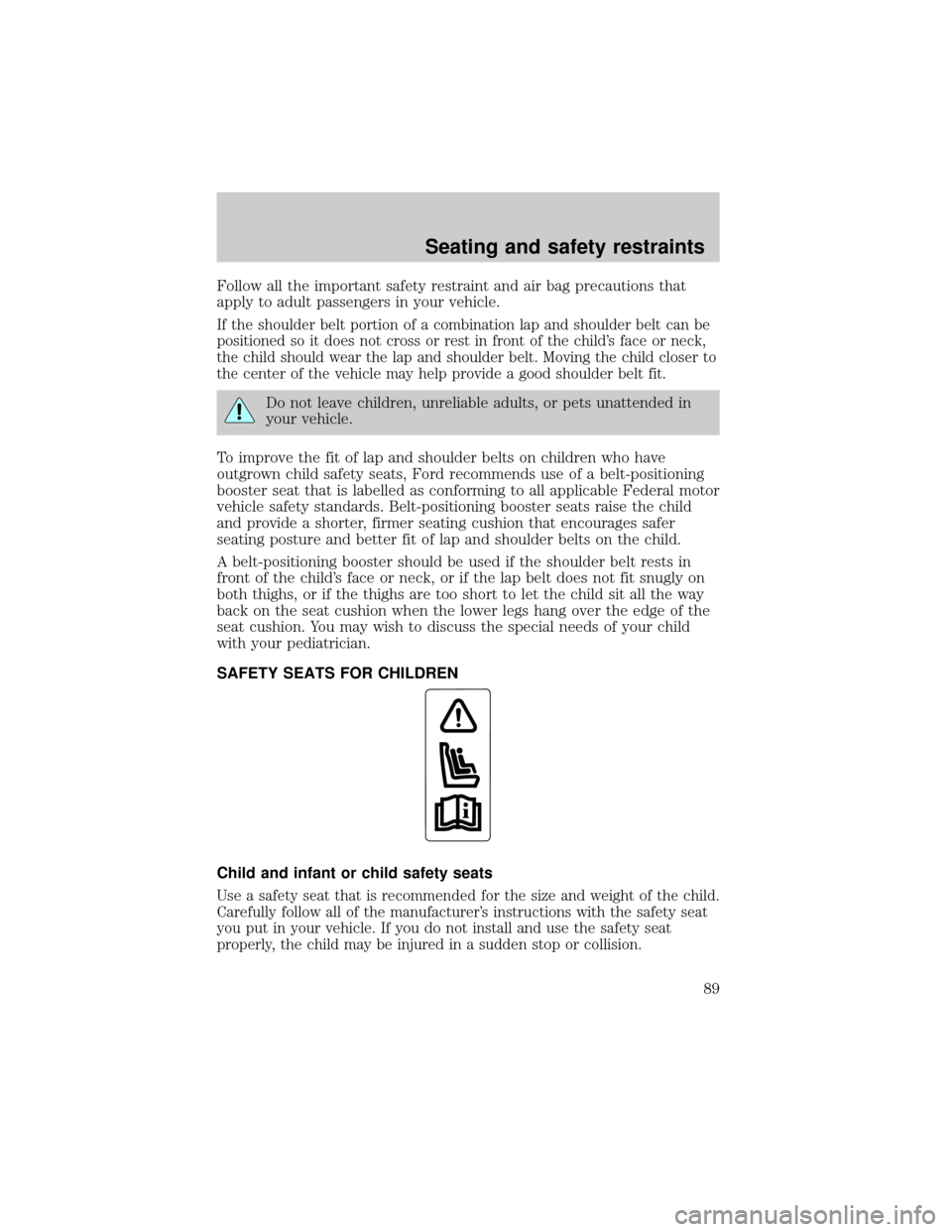
Follow all the important safety restraint and air bag precautions that
apply to adult passengers in your vehicle.
If the shoulder belt portion of a combination lap and shoulder belt can be
positioned so it does not cross or rest in front of the child's face or neck,
the child should wear the lap and shoulder belt. Moving the child closer to
the center of the vehicle may help provide a good shoulder belt fit.
Do not leave children, unreliable adults, or pets unattended in
your vehicle.
To improve the fit of lap and shoulder belts on children who have
outgrown child safety seats, Ford recommends use of a belt-positioning
booster seat that is labelled as conforming to all applicable Federal motor
vehicle safety standards. Belt-positioning booster seats raise the child
and provide a shorter, firmer seating cushion that encourages safer
seating posture and better fit of lap and shoulder belts on the child.
A belt-positioning booster should be used if the shoulder belt rests in
front of the child's face or neck, or if the lap belt does not fit snugly on
both thighs, or if the thighs are too short to let the child sit all the way
back on the seat cushion when the lower legs hang over the edge of the
seat cushion. You may wish to discuss the special needs of your child
with your pediatrician.
SAFETY SEATS FOR CHILDREN
Child and infant or child safety seats
Use a safety seat that is recommended for the size and weight of the child.
Carefully follow all of the manufacturer's instructions with the safety seat
you put in your vehicle. If you do not install and use the safety seat
properly, the child may be injured in a sudden stop or collision.
Seating and safety restraints
89
Page 109 of 224

1 (First)
Use 1 (Low) to provide maximum
engine braking on steep
downgrades. Upshifts can be made
by shifting to 2 (Second) or to
(Overdrive). Selecting 1 (Low) at
higher speeds causes the transmission to shift to a lower gear, and will
shift to 1 (Low) after vehicle decelerates to the proper speed.
Forced Downshifts
To gain acceleration in(Overdrive) or Drive (O/D OFF) when
passing another vehicle, push the accelerator to the floor. The
transmission will downshift to the appropriate gear: third, second or first
gear.
Shift strategy (4R100 automatic transmission)
To account for customer driving habits and conditions, your 4R100
automatic transmission electronically controls the shift quality by using
an adaptive learning strategy. The adaptive learning strategy is
maintained by power from the battery. When the battery is disconnected
or a new battery is installed, the transmission must relearn its adaptive
strategy. Optimal shifting will resume within a few hundred kilometers
(miles) of operation.
If the shift quality does not improve within a few hundred
kilometers (miles) of operation, or if the downshifts and other
throttle conditions do not function normally, see your dealer or a
qualified service technician as soon as possible.
VEHICLE LOADING
Before loading a vehicle, familiarize yourself with the following terms:
²Base Curb Weight:Weight of the vehicle including any standard
equipment, fluids, lubricants, etc. It does not include passengers or
aftermarket equipment.
²Payload:Combined maximum allowable weight of cargo, passengers
and optional equipment. The payload equals the gross vehicle weight
rating minus base curb weight.
²GVW (Gross Vehicle Weight):Base curb weight plus payload
weight. The GVW is not a limit or a specification.
Driving
109
Page 110 of 224
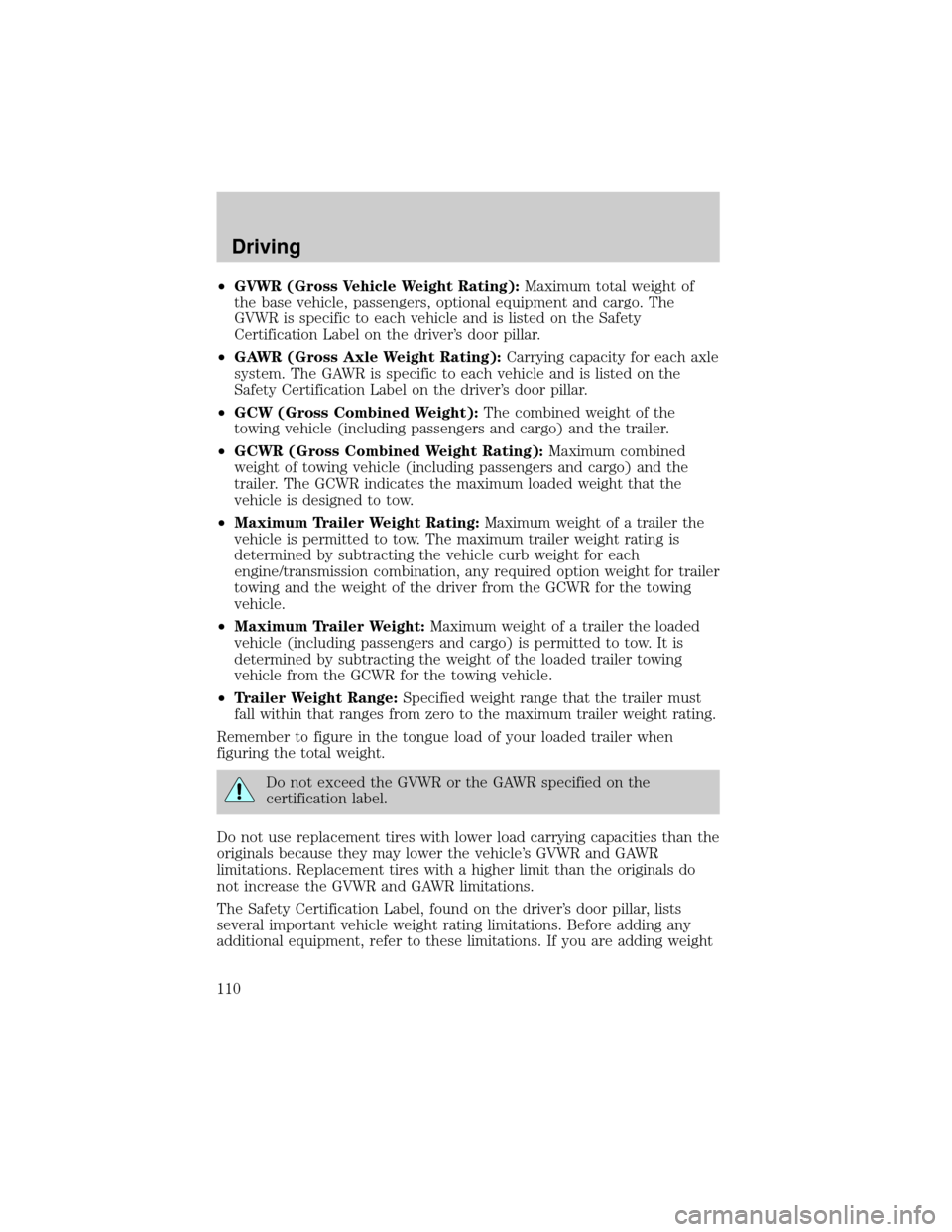
²GVWR (Gross Vehicle Weight Rating):Maximum total weight of
the base vehicle, passengers, optional equipment and cargo. The
GVWR is specific to each vehicle and is listed on the Safety
Certification Label on the driver's door pillar.
²GAWR (Gross Axle Weight Rating):Carrying capacity for each axle
system. The GAWR is specific to each vehicle and is listed on the
Safety Certification Label on the driver's door pillar.
²GCW (Gross Combined Weight):The combined weight of the
towing vehicle (including passengers and cargo) and the trailer.
²GCWR (Gross Combined Weight Rating):Maximum combined
weight of towing vehicle (including passengers and cargo) and the
trailer. The GCWR indicates the maximum loaded weight that the
vehicle is designed to tow.
²Maximum Trailer Weight Rating:Maximum weight of a trailer the
vehicle is permitted to tow. The maximum trailer weight rating is
determined by subtracting the vehicle curb weight for each
engine/transmission combination, any required option weight for trailer
towing and the weight of the driver from the GCWR for the towing
vehicle.
²Maximum Trailer Weight:Maximum weight of a trailer the loaded
vehicle (including passengers and cargo) is permitted to tow. It is
determined by subtracting the weight of the loaded trailer towing
vehicle from the GCWR for the towing vehicle.
²Trailer Weight Range:Specified weight range that the trailer must
fall within that ranges from zero to the maximum trailer weight rating.
Remember to figure in the tongue load of your loaded trailer when
figuring the total weight.
Do not exceed the GVWR or the GAWR specified on the
certification label.
Do not use replacement tires with lower load carrying capacities than the
originals because they may lower the vehicle's GVWR and GAWR
limitations. Replacement tires with a higher limit than the originals do
not increase the GVWR and GAWR limitations.
The Safety Certification Label, found on the driver's door pillar, lists
several important vehicle weight rating limitations. Before adding any
additional equipment, refer to these limitations. If you are adding weight
Driving
110
Page 111 of 224
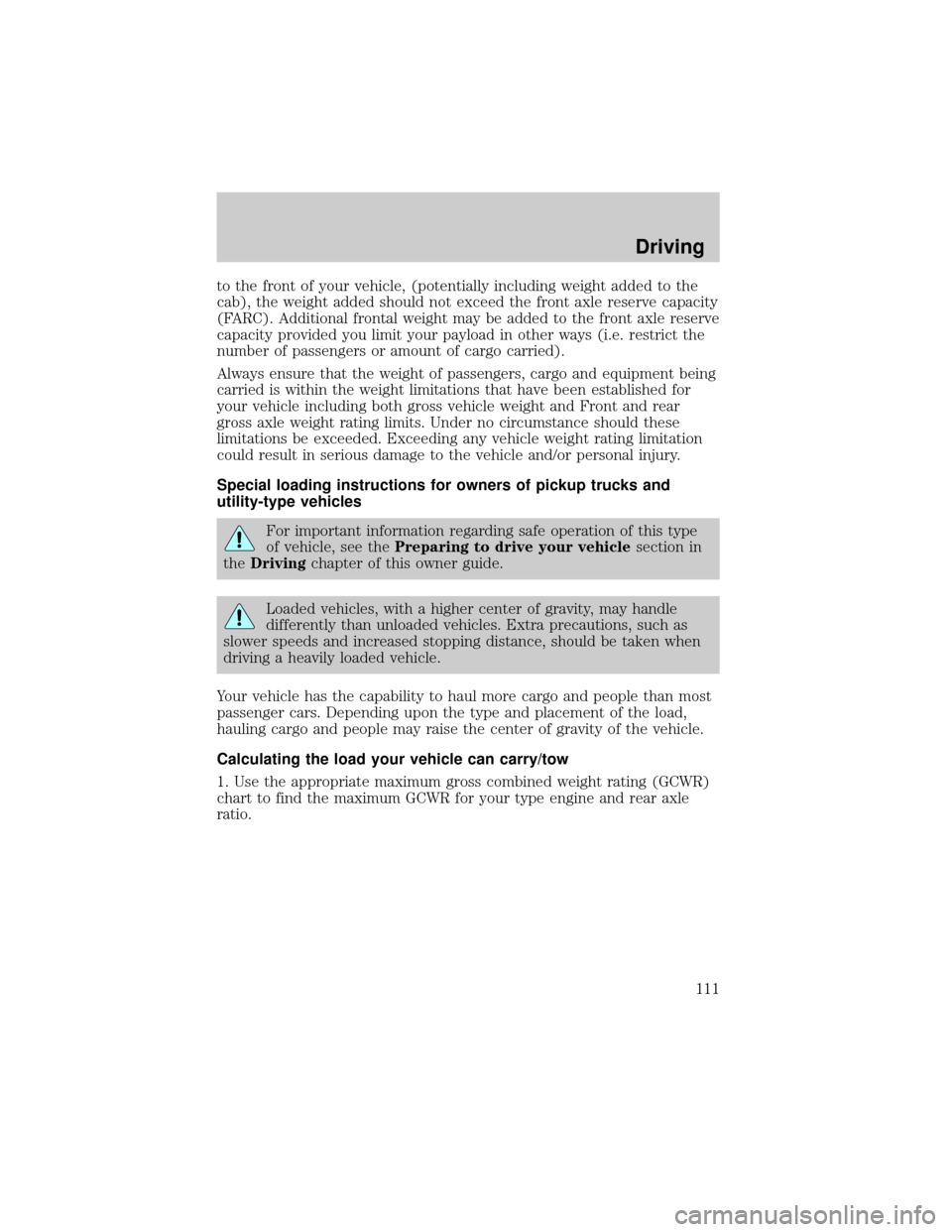
to the front of your vehicle, (potentially including weight added to the
cab), the weight added should not exceed the front axle reserve capacity
(FARC). Additional frontal weight may be added to the front axle reserve
capacity provided you limit your payload in other ways (i.e. restrict the
number of passengers or amount of cargo carried).
Always ensure that the weight of passengers, cargo and equipment being
carried is within the weight limitations that have been established for
your vehicle including both gross vehicle weight and Front and rear
gross axle weight rating limits. Under no circumstance should these
limitations be exceeded. Exceeding any vehicle weight rating limitation
could result in serious damage to the vehicle and/or personal injury.
Special loading instructions for owners of pickup trucks and
utility-type vehicles
For important information regarding safe operation of this type
of vehicle, see thePreparing to drive your vehiclesection in
theDrivingchapter of this owner guide.
Loaded vehicles, with a higher center of gravity, may handle
differently than unloaded vehicles. Extra precautions, such as
slower speeds and increased stopping distance, should be taken when
driving a heavily loaded vehicle.
Your vehicle has the capability to haul more cargo and people than most
passenger cars. Depending upon the type and placement of the load,
hauling cargo and people may raise the center of gravity of the vehicle.
Calculating the load your vehicle can carry/tow
1. Use the appropriate maximum gross combined weight rating (GCWR)
chart to find the maximum GCWR for your type engine and rear axle
ratio.
Driving
111
Page 112 of 224
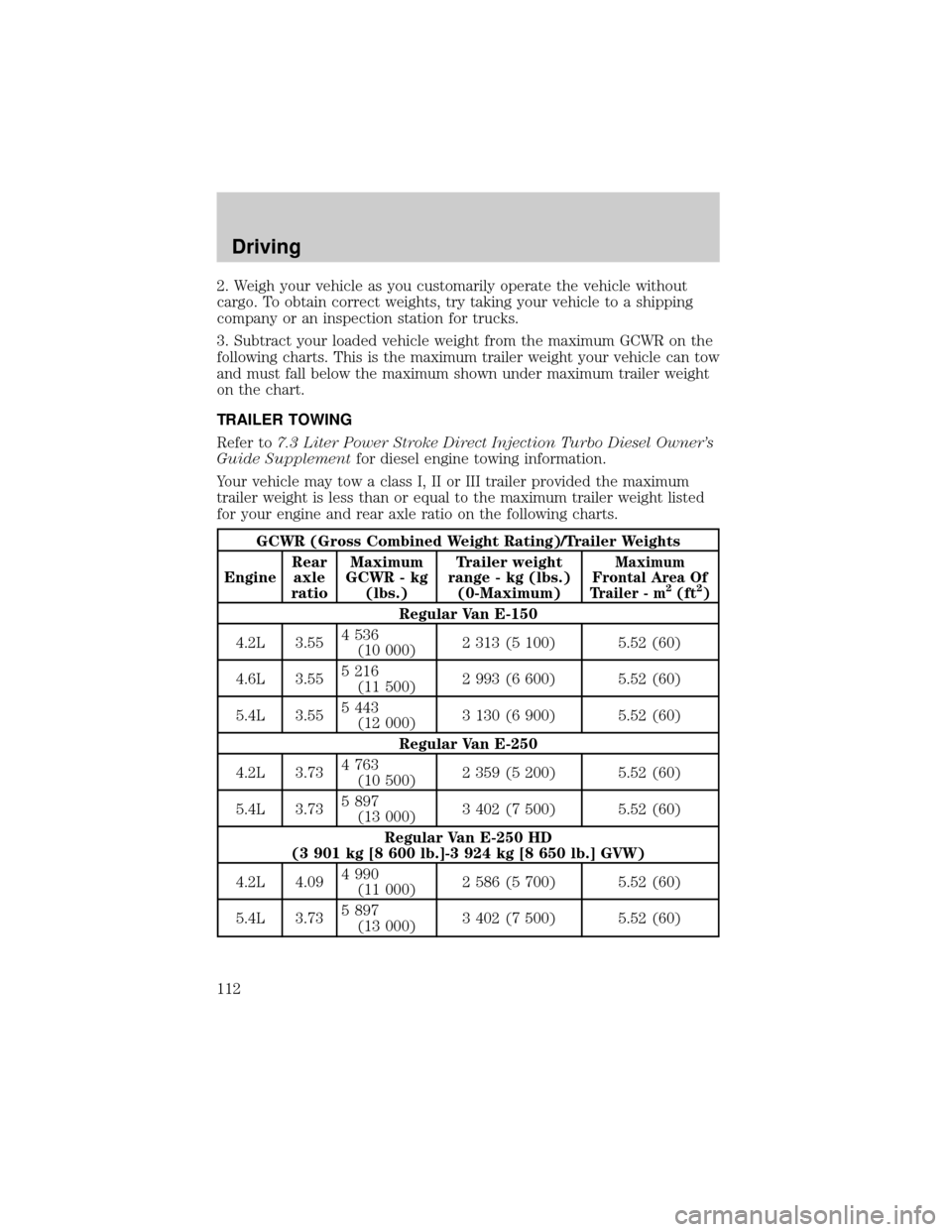
2. Weigh your vehicle as you customarily operate the vehicle without
cargo. To obtain correct weights, try taking your vehicle to a shipping
company or an inspection station for trucks.
3. Subtract your loaded vehicle weight from the maximum GCWR on the
following charts. This is the maximum trailer weight your vehicle can tow
and must fall below the maximum shown under maximum trailer weight
on the chart.
TRAILER TOWING
Refer to7.3 Liter Power Stroke Direct Injection Turbo Diesel Owner's
Guide Supplementfor diesel engine towing information.
Your vehicle may tow a class I, II or III trailer provided the maximum
trailer weight is less than or equal to the maximum trailer weight listed
for your engine and rear axle ratio on the following charts.
GCWR (Gross Combined Weight Rating)/Trailer Weights
EngineRear
axle
ratioMaximum
GCWR - kg
(lbs.)Trailer weight
range - kg (lbs.)
(0-Maximum)
Maximum
Frontal Area Of
Trailer - m
2(ft2)
Regular Van E-150
4.2L 3.554 536
(10 000)2 313 (5 100) 5.52 (60)
4.6L 3.555 216
(11 500)2 993 (6 600) 5.52 (60)
5.4L 3.555 443
(12 000)3 130 (6 900) 5.52 (60)
Regular Van E-250
4.2L 3.734 763
(10 500)2 359 (5 200) 5.52 (60)
5.4L 3.735 897
(13 000)3 402 (7 500) 5.52 (60)
Regular Van E-250 HD
(3 901 kg [8 600 lb.]-3 924 kg [8 650 lb.] GVW)
4.2L 4.094 990
(11 000)2 586 (5 700) 5.52 (60)
5.4L 3.735 897
(13 000)3 402 (7 500) 5.52 (60)
Driving
112
Page 113 of 224
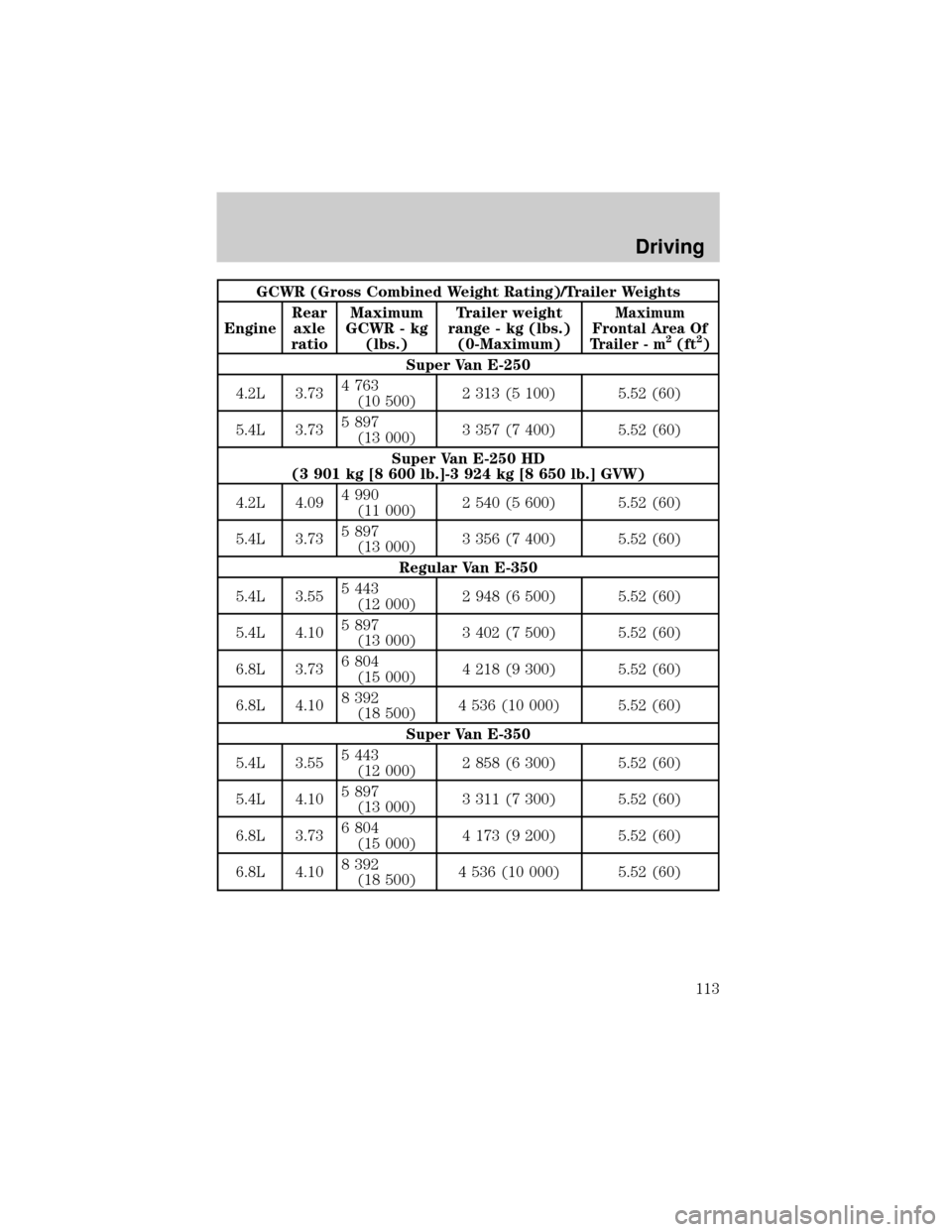
GCWR (Gross Combined Weight Rating)/Trailer Weights
EngineRear
axle
ratioMaximum
GCWR - kg
(lbs.)Trailer weight
range - kg (lbs.)
(0-Maximum)
Maximum
Frontal Area Of
Trailer - m
2(ft2)
Super Van E-250
4.2L 3.734 763
(10 500)2 313 (5 100) 5.52 (60)
5.4L 3.735 897
(13 000)3 357 (7 400) 5.52 (60)
Super Van E-250 HD
(3 901 kg [8 600 lb.]-3 924 kg [8 650 lb.] GVW)
4.2L 4.094 990
(11 000)2 540 (5 600) 5.52 (60)
5.4L 3.735 897
(13 000)3 356 (7 400) 5.52 (60)
Regular Van E-350
5.4L 3.555 443
(12 000)2 948 (6 500) 5.52 (60)
5.4L 4.105 897
(13 000)3 402 (7 500) 5.52 (60)
6.8L 3.736 804
(15 000)4 218 (9 300) 5.52 (60)
6.8L 4.108 392
(18 500)4 536 (10 000) 5.52 (60)
Super Van E-350
5.4L 3.555 443
(12 000)2 858 (6 300) 5.52 (60)
5.4L 4.105 897
(13 000)3 311 (7 300) 5.52 (60)
6.8L 3.736 804
(15 000)4 173 (9 200) 5.52 (60)
6.8L 4.108 392
(18 500)4 536 (10 000) 5.52 (60)
Driving
113
Page 114 of 224
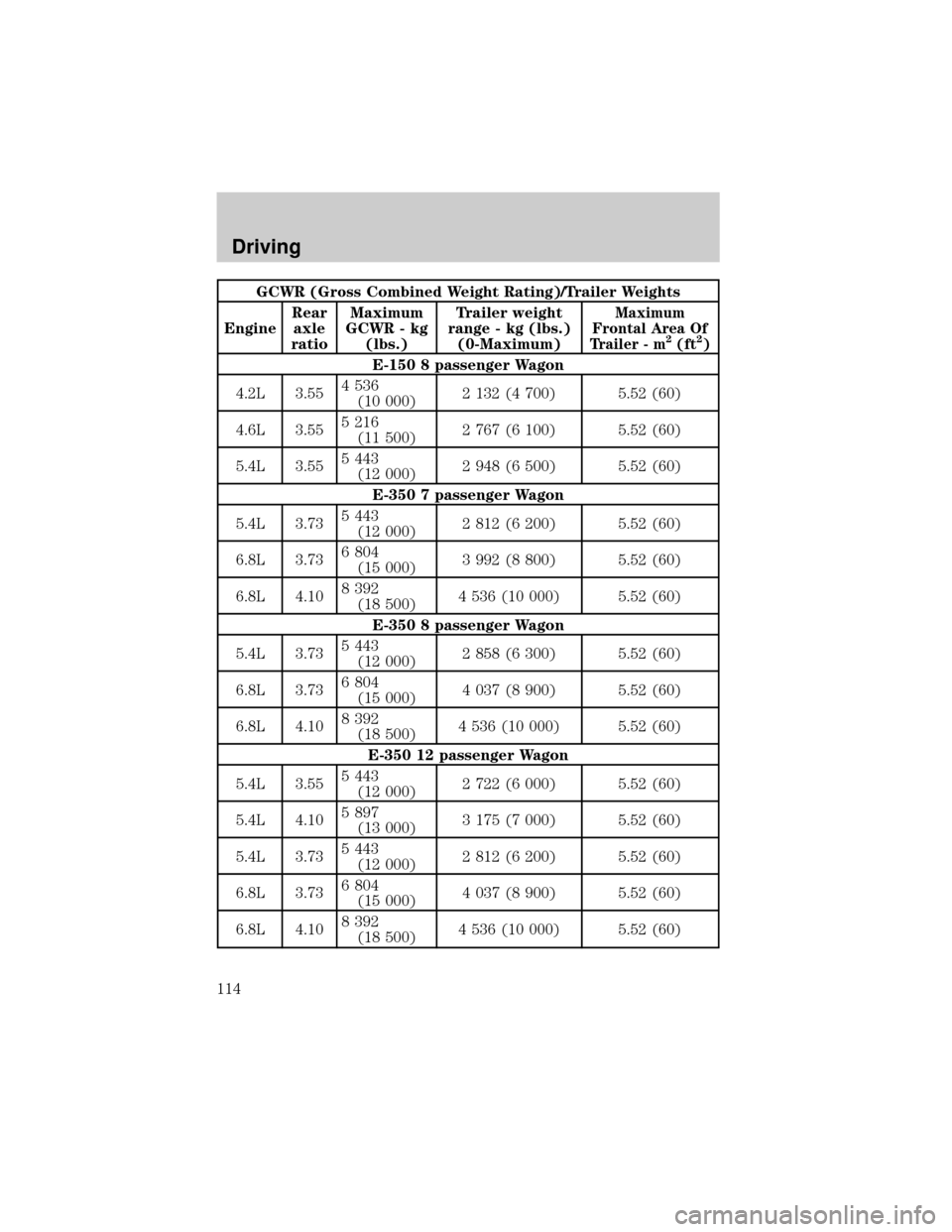
GCWR (Gross Combined Weight Rating)/Trailer Weights
EngineRear
axle
ratioMaximum
GCWR - kg
(lbs.)Trailer weight
range - kg (lbs.)
(0-Maximum)
Maximum
Frontal Area Of
Trailer - m
2(ft2)
E-150 8 passenger Wagon
4.2L 3.554 536
(10 000)2 132 (4 700) 5.52 (60)
4.6L 3.555 216
(11 500)2 767 (6 100) 5.52 (60)
5.4L 3.555 443
(12 000)2 948 (6 500) 5.52 (60)
E-350 7 passenger Wagon
5.4L 3.735 443
(12 000)2 812 (6 200) 5.52 (60)
6.8L 3.736 804
(15 000)3 992 (8 800) 5.52 (60)
6.8L 4.108 392
(18 500)4 536 (10 000) 5.52 (60)
E-350 8 passenger Wagon
5.4L 3.735 443
(12 000)2 858 (6 300) 5.52 (60)
6.8L 3.736 804
(15 000)4 037 (8 900) 5.52 (60)
6.8L 4.108 392
(18 500)4 536 (10 000) 5.52 (60)
E-350 12 passenger Wagon
5.4L 3.555 443
(12 000)2 722 (6 000) 5.52 (60)
5.4L 4.105 897
(13 000)3 175 (7 000) 5.52 (60)
5.4L 3.735 443
(12 000)2 812 (6 200) 5.52 (60)
6.8L 3.736 804
(15 000)4 037 (8 900) 5.52 (60)
6.8L 4.108 392
(18 500)4 536 (10 000) 5.52 (60)
Driving
114
Page 115 of 224
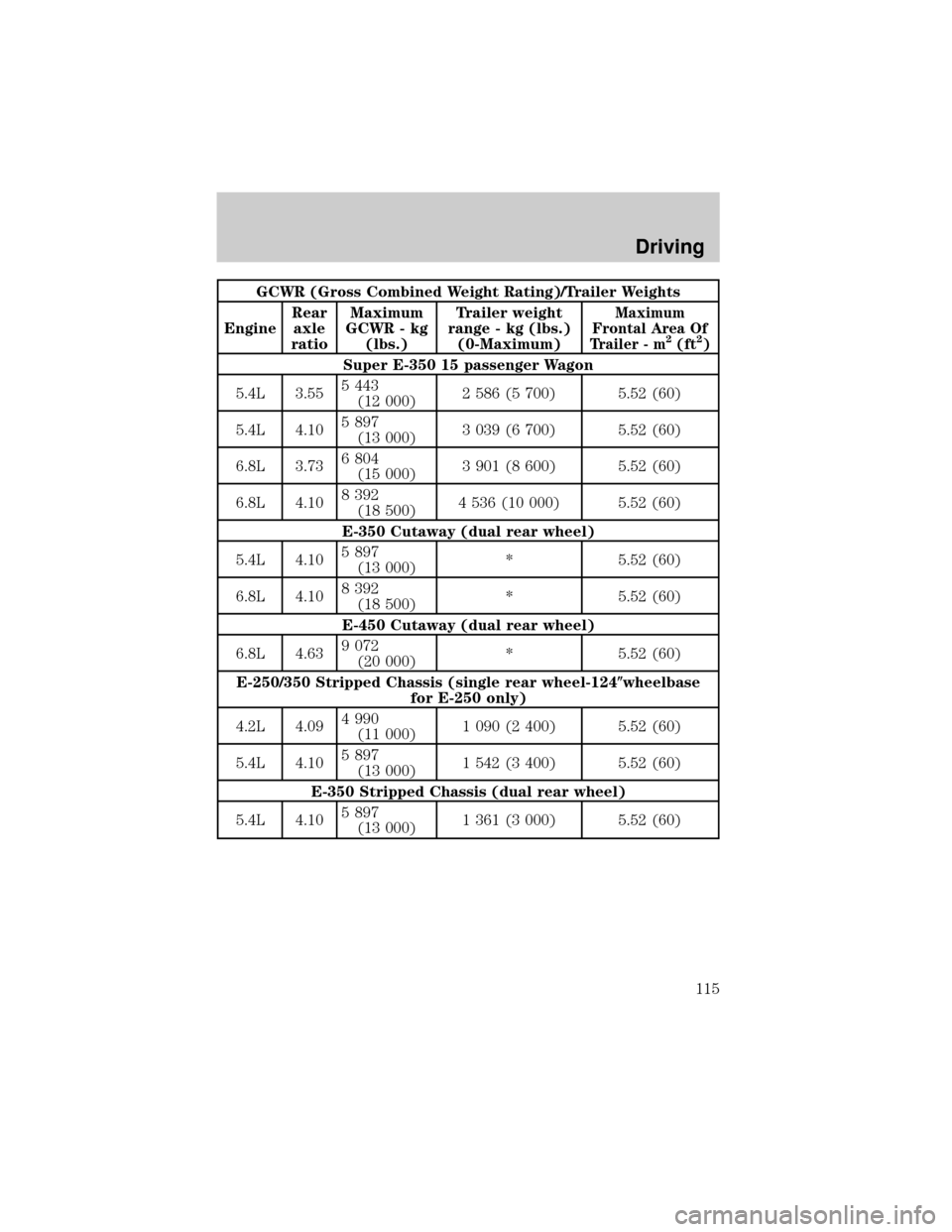
GCWR (Gross Combined Weight Rating)/Trailer Weights
EngineRear
axle
ratioMaximum
GCWR - kg
(lbs.)Trailer weight
range - kg (lbs.)
(0-Maximum)
Maximum
Frontal Area Of
Trailer - m
2(ft2)
Super E-350 15 passenger Wagon
5.4L 3.555 443
(12 000)2 586 (5 700) 5.52 (60)
5.4L 4.105 897
(13 000)3 039 (6 700) 5.52 (60)
6.8L 3.736 804
(15 000)3 901 (8 600) 5.52 (60)
6.8L 4.108 392
(18 500)4 536 (10 000) 5.52 (60)
E-350 Cutaway (dual rear wheel)
5.4L 4.105 897
(13 000)* 5.52 (60)
6.8L 4.108 392
(18 500)* 5.52 (60)
E-450 Cutaway (dual rear wheel)
6.8L 4.639 072
(20 000)* 5.52 (60)
E-250/350 Stripped Chassis (single rear wheel-124(wheelbase
for E-250 only)
4.2L 4.094 990
(11 000)1 090 (2 400) 5.52 (60)
5.4L 4.105 897
(13 000)1 542 (3 400) 5.52 (60)
E-350 Stripped Chassis (dual rear wheel)
5.4L 4.105 897
(13 000)1 361 (3 000) 5.52 (60)
Driving
115
Page 116 of 224
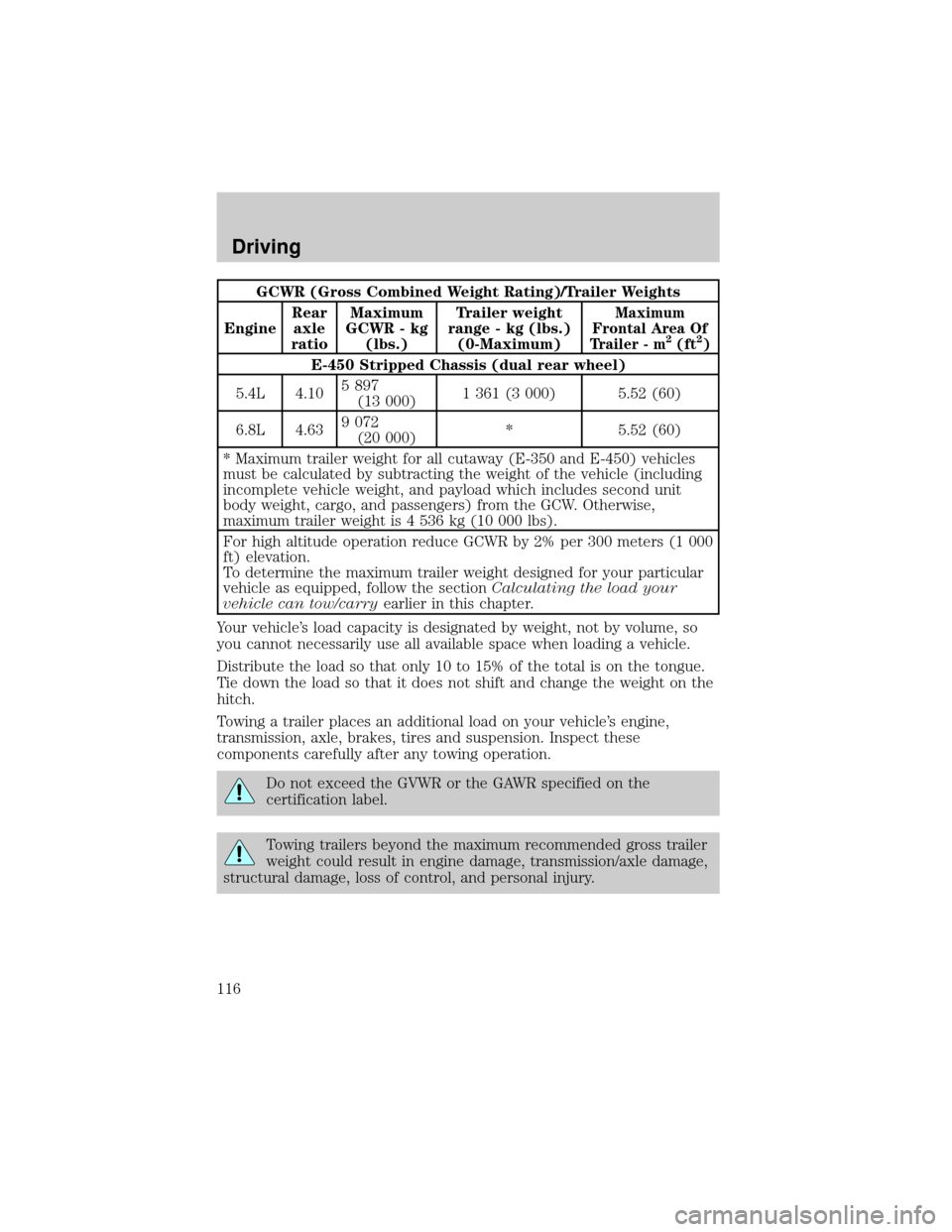
GCWR (Gross Combined Weight Rating)/Trailer Weights
EngineRear
axle
ratioMaximum
GCWR - kg
(lbs.)Trailer weight
range - kg (lbs.)
(0-Maximum)
Maximum
Frontal Area Of
Trailer - m
2(ft2)
E-450 Stripped Chassis (dual rear wheel)
5.4L 4.105 897
(13 000)1 361 (3 000) 5.52 (60)
6.8L 4.639 072
(20 000)* 5.52 (60)
* Maximum trailer weight for all cutaway (E-350 and E-450) vehicles
must be calculated by subtracting the weight of the vehicle (including
incomplete vehicle weight, and payload which includes second unit
body weight, cargo, and passengers) from the GCW. Otherwise,
maximum trailer weight is 4 536 kg (10 000 lbs).
For high altitude operation reduce GCWR by 2% per 300 meters (1 000
ft) elevation.
To determine the maximum trailer weight designed for your particular
vehicle as equipped, follow the sectionCalculating the load your
vehicle can tow/carryearlier in this chapter.
Your vehicle's load capacity is designated by weight, not by volume, so
you cannot necessarily use all available space when loading a vehicle.
Distribute the load so that only 10 to 15% of the total is on the tongue.
Tie down the load so that it does not shift and change the weight on the
hitch.
Towing a trailer places an additional load on your vehicle's engine,
transmission, axle, brakes, tires and suspension. Inspect these
components carefully after any towing operation.
Do not exceed the GVWR or the GAWR specified on the
certification label.
Towing trailers beyond the maximum recommended gross trailer
weight could result in engine damage, transmission/axle damage,
structural damage, loss of control, and personal injury.
Driving
116
Page 117 of 224
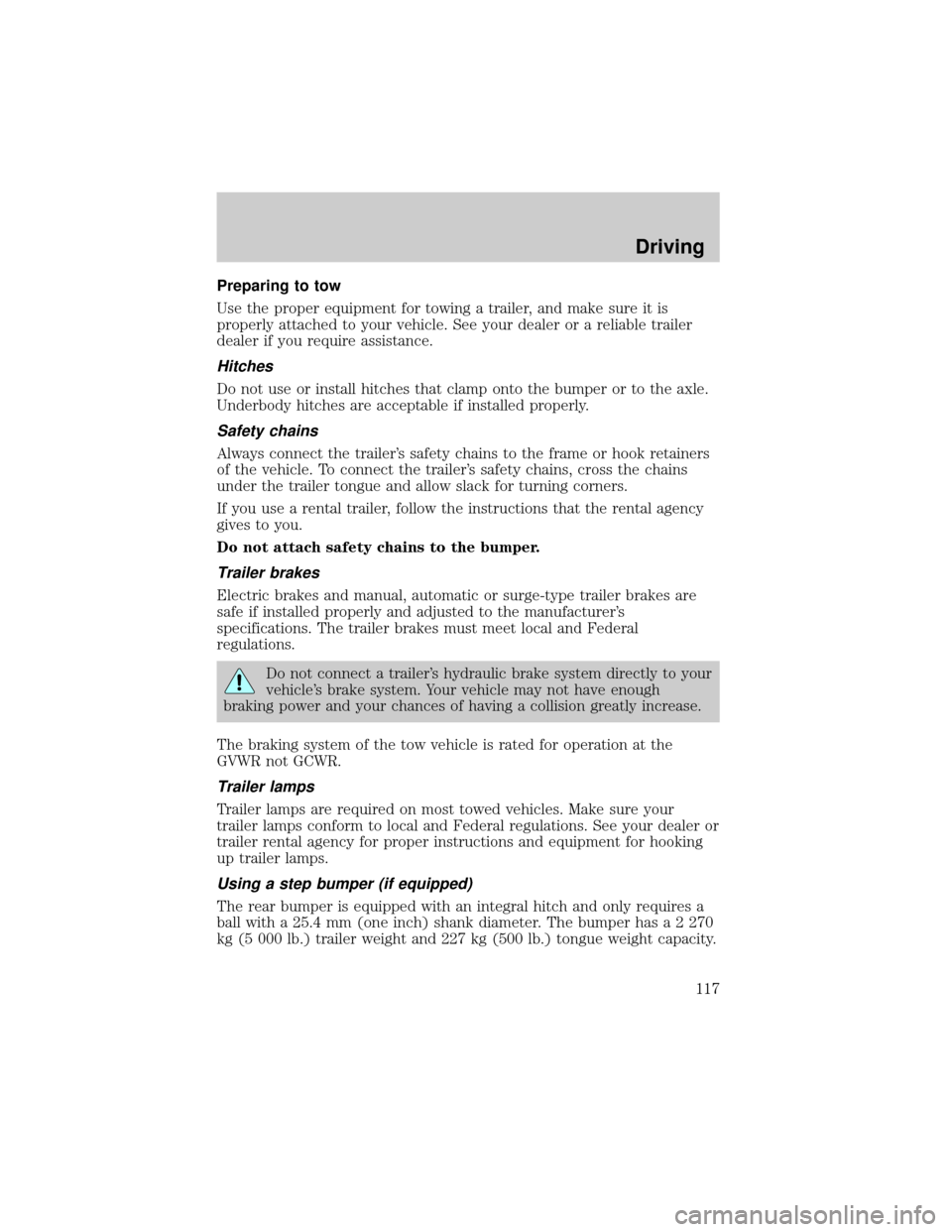
Preparing to tow
Use the proper equipment for towing a trailer, and make sure it is
properly attached to your vehicle. See your dealer or a reliable trailer
dealer if you require assistance.
Hitches
Do not use or install hitches that clamp onto the bumper or to the axle.
Underbody hitches are acceptable if installed properly.
Safety chains
Always connect the trailer's safety chains to the frame or hook retainers
of the vehicle. To connect the trailer's safety chains, cross the chains
under the trailer tongue and allow slack for turning corners.
If you use a rental trailer, follow the instructions that the rental agency
gives to you.
Do not attach safety chains to the bumper.
Trailer brakes
Electric brakes and manual, automatic or surge-type trailer brakes are
safe if installed properly and adjusted to the manufacturer's
specifications. The trailer brakes must meet local and Federal
regulations.
Do not connect a trailer's hydraulic brake system directly to your
vehicle's brake system. Your vehicle may not have enough
braking power and your chances of having a collision greatly increase.
The braking system of the tow vehicle is rated for operation at the
GVWR not GCWR.
Trailer lamps
Trailer lamps are required on most towed vehicles. Make sure your
trailer lamps conform to local and Federal regulations. See your dealer or
trailer rental agency for proper instructions and equipment for hooking
up trailer lamps.
Using a step bumper (if equipped)
The rear bumper is equipped with an integral hitch and only requires a
ball with a 25.4 mm (one inch) shank diameter. The bumper hasa2270
kg (5 000 lb.) trailer weight and 227 kg (500 lb.) tongue weight capacity.
Driving
117